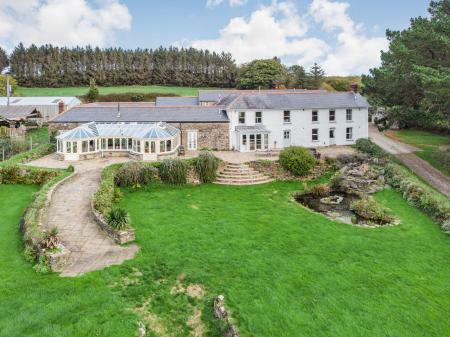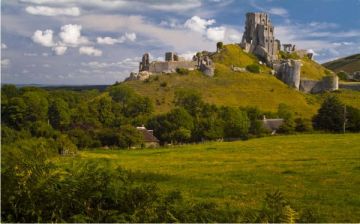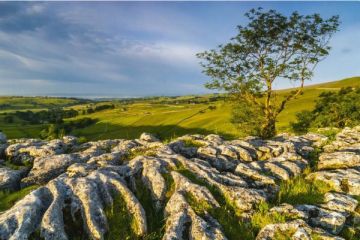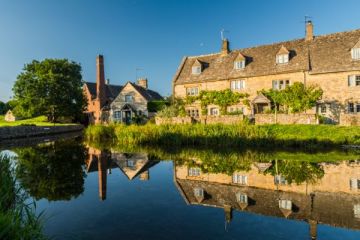Many of Britain's best stately homes share a historical garden feature - a hedge maze, where visitors can lose themselves (literally) in often-hilarious attempts to find their way to the centre or simply to escape once they've given up. Some of the finest mazes date back hundreds of years. Here we look at some of our family favourites.
Maze or Labyrinth?
You will often see the terms maze and labyrinth used interchangeably, as if they referred to the same thing, but the words actually describe two very different things. A labyrinth is 'unicursal', that is, it consists of a single pathway. All you have to do is follow the pathway and you will come to the centre of the labyrinth.
A maze, by contrast, is 'multicursal', with many pathways. These pathways often end in dead ends, so that you have to retrace your steps and try again. It is impossible to get lost in a labyrinth; all you have to do is keep following the path. It is, however, very easy to get lost in a maze, and that's part of the fun!
The most famous 'labyrinth' in history was the one at Minos in Crete, where the fearsome Minotaur was imprisoned. In fact, this had to have been a maze, otherwise, it would have been very easy for the Minotaur to escape!
Labyrinths were often used as aids to spiritual practice during the medieval period. Worshippers would use the steps along the path as a focus for meditation or prayer.

Perhaps the oldest labyrinth in Britain is in Rocky Valley, near Tintagel in Cornwall, where two unicursal designs are carved onto an exposed rock face. These labyrinths are thought to be as much as 4,000 years old - though some historians argue that they are more likely of Celtic origin, or are, indeed, relatively modern.
Hedge Mazes

The oldest and most famous hedge maze in Britain is in the grounds of Hampton Court Palace, on the outskirts of London. The maze was commissioned by King William III in 1700 and laid out by Henry Wise and George London.
The maze is an odd trapezoid shape and covers a third of an acre. It was originally planted in hornbeam but later replanted with yew. It was one of two formal mazes planted in the area of the royal gardens known as The Wilderness, but it is the one to survive.
It was intended as a puzzle maze; one that made visitors think, rather than a simple unicursal design popular until that time. The royal hedge maze at Hampton Court started a fashion for puzzle mazes, but most were destroyed during the 18th-century as a new fashion for a more naturalistic English landscape garden took hold.
Capability Brown was one of the foremost designers of landscape gardens, and he served as the Royal Gardener for 20 years. His official residence was directly beside the maze. Brown might have been keen to replace the formal maze, but he was ordered by the king to keep his hands off it!

The maze at Hampton Court Palace was influential in design but relatively small. At the other extreme is the Marlborough Maze in the grounds of Blenheim Palace in Oxfordshire, which covers almost 2 acres and is composed of 3,000 different yew hedges, making up 2 miles of hedges in total.
Two wooden bridges are incorporated into the design, which gives you a birds-eye view, very helpful in planning your route to the centre. The head gardener estimated that it takes six gardeners an entire week to trim and maintain the hedges each year.
The design is symbolic, incorporating shapes based on Grinling Gibbons' Panoply of Victory roof carvings inside the Palace. It also incorporates a V sign in honour of Sir Winston Churchill, who was born at Blenheim Palace.
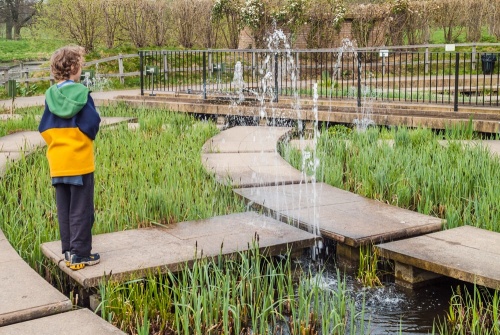
This picturesque moated castle is known for its links to Henry VIII and his second wife Anne Boleyn, who grew up at Hever. The historic castle stands in superb formal gardens, including an Italianate garden dotted with classical statues and sculpture. Next to the castle's forecourt is a hedge maze installed by William Waldorf Astor, who bought Hever Castle in the early 20th century.
The maze measures exactly 80 feet by 80 feet, with hedges eight feet high. The hedges contain a quarter-mile of pathways.
But there is more than just a hedge maze at Hever, there is an extremely popular water maze. The water maze consists of 16 acres of stepping stones in a concentric design, laid out over water. As you walk, the paving stones randomly tilt and send up a jet of water, soaking the unwary visitor. Our children were in stitches of laughter, especially when they convinced their unsuspecting mother to try the maze only to end up sprayed with water.

Scone is known as the traditional crowning place of Scottish rulers. In the gardens surrounding the sprawling mansion is a modern maze based on the design of a five-pointed star and the family crest of the Murray's, who have lived here for centuries. The maze is formed from a mix of copper and green beech trees to create a two-toned effect reminiscent of the Murray family tartan.
The maze was laid out in 1991 by Adrian Fisher, and internationally famous maze artist. At the centre is a bronze statue of Arethusa, a Greek water nymph.
The maze covers roughly 1,600 square metres (0.4 acres) and is made with 2,000 beech trees. There are more than 800m of paths, but the most direct route to the centre of the maze is just 30m.

Traquair House is the oldest inhabited house in Scotland, with a history going back to at least 1107 when Alexander I of Scotland signed a royal charter here.
The maze, by contrast, is one of the most modern, installed in 1981. It covers more than half an acre and the path to the centre is over a quarter-mile long. Terrace walls surrounding the maze offer a good vantage point for planning your route to the centre - and for watching the sometimes futile attempts of other visitors.
The maze was originally planted with over 1,500 cypress trees, but a severe winter in 1983 caused 7o% of the trees to die. The maze was replanted with hardier beech trees, which had the extra benefit of creating more colourful path boundaries.
The maze occupies an area of garden behind the house that was originally a formal 18th-century parterre. Unusually, the maze has no dead ends and four 'sub-centres' rather than the more typical maze with numerous dead ends and one centre.

Cawdor Castle will forever be associated with the legend of Macbeth - both the real-life king of Scotland and the murderous character portrayed by Shakespeare centuries later. The castle we see today dates to the 14th century and was built, according to folklore, around a living thorn tree after the Thane of Cawdor had a prophetic dream. It might be easy to dismiss the story as mere fancy, but indeed there is a living thorn tree growing from the earthen floor of the tower's vaulted guard room.
Cawdor Castle is surrounded by beautiful gardens. The oldest part of the gardens is the walled garden, which may date to the 16th century or perhaps even earlier. The upper half of the walled garden has been laid out as an intricate maze depicting the Minotaur's Labyrinth at Knossos in Crete. At the centre of the maze is a modern sculpture depicting the Minotaur, created by American sculptor Gregory Ryan. The maze is made from over 1,200 holly plants.

One of the more recent mazes on this list, designed for one of the oldest houses! The story of Leeds Castle goes back to 1119, and the estate was often owned by the reigning queen. The castle is built on a series of small islands in a lake.
The maze was laid out in 1988 by Vernon Gibberd. The centre of the design resembles a queen's crown, a reminder that Leeds Castle was considered a queen's residence. The maze uses 2,400 yew trees. In the centre is a subterranean grotto made from wood, rocks and shells, creating the ambience of a secret lair. It is not a place you want to bring children who scare easily!

One of the oldest mazes on this list is the one at Glendurgan Gardens, a National Trust property near Falmouth. Glendurgan is set in a lovely valley sloping down to the Helford estuary.
The maze was designed in the 1820s but not actually planted until 1833. It is formed by cherry laurel, with palm trees at each corner and a thatched summerhouse in the centre of the maze. You can get wonderful views looking down over the maze from a garden path high on the hill overlooking the valley floor.
Glendurgan was the home of the Fox family, who developed the garden as a private retreat over the course o 20 years. The steep-sided valley creates a protected environment where tender plants can thrive, including cypress trees and Japanese loquats.
Alfred Fox designed the maze to be a challenging puzzle. It is laid out in the form of a serpent with coils that get tighter as you near the centre. The serpent's coils stretch three-quarters of a mile.

If you visit just one maze on this list you could do worse than to make it the maze at Longleat. This is the longest hedge maze in the world (though not technically the largest). It was designed in 1975 and covers an area of 1.48 acres. There are 1.69 miles of paths and wooden bridges to offer a raised vantage point for planning your next move. The hedge is made up of over 16,000 English yew trees.
The mansion of Longleat was built in 1580 by Sir John Thynne, a prominent statesman at the court of Elizabeth I. The opulent Italianate house stands in 900 acres of parkland landscaped by Lancelot 'Capability' Brown.

This sunken maze was laid out in 1962. The designer was Denis Fisher, Comptroller for the 11th Duke of Devonshire. It features precisely 1,209 English yews. Aligned on the centre of the maze is The Hundred Steps, created in the 1980s.
One of Chatsworth's most popular garden features is the Emperor Fountain, designed by Joseph Paxton, who served as the head gardener to the 2nd Duke. Paxton also designed elaborate glasshouses that were the inspiration for today's modern greenhouses.
Chatsworth is the home of the Cavendish family, the Dukes and Duchesses of Devonshire. It was built in 1552 by Sir William Cavendish and his wife Elizabeth, better known to history as Bess of Hardwick. Mary, Queen of Scots was held prisoner at Chatsworth for extended periods between 1569 and 1584.
The house is filled with a superb collection of fine art, much of it collected by William Cavendish the 2nd Duke of Devonshire.

Cliveden House is one of Britain's great stately homes. The house stands on a bend in the River Thames not far from Windsor. The house was begun in 1666 by George Villers, the 2nd Duke of Buckingham and a favourite of Charles II. It was destroyed by fire in 1849 and was rebuilt by Sir Charles Barry, the architect of the Palace of Westminster in London.
In 1893 William Waldorf Astor (see Hever Castle) purchased the estate. Aside from restoring and extending the house, Astor designed and built a hedge maze in 1894. His maze was later destroyed but by good fortune, Astor's original drawings survived and a new maze was laid out to the same plan. This new/old maze is made up of over 1,000 yew trees and is known as Lord Astor's Giant Puzzle.

The maze beside Somerleyton Hall was laid out in 1846 by the famous Victorian gardener William Nesfield. It is just one of Nesfield's designs for the 12 acres of formal gardens, which include a parterre and a rose garden. Another garden feature is a greenhouse by Joseph Paxton, who designed the Crystal Palace for the 1851 Great Exhibition.
The history of Somerleyton Hall goes back to at least 1240 but the Italianate house we see today was the work of Samuel Peto, a wealthy businessman and MP. Peto's son was Harold Peto, who himself became a popular architect and garden designer (see Iford Manor).

Woburn Abbey began as a Cistercian monastery but it has been the home of the Dukes of Bedford since the 17th century. The elegant house is one of the finest stately homes in England and is set in equally impressive historic gardens.
One garden feature is the Hornbeam Maze, designed for the 6th Duke of Bedford in 1831. The maze suffered from years of neglect but was recently completely restored.
At the centre of the maze is a Chinese pagoda, a reminder of the fashion for Oriental style that swept English architecture and design in the early Victorian period. The pagoda is based on a 1757 design by Sir William Chambers but was erected in 1833.
Turf Mazes
In addition to hedge mazes, usually found as garden features in stately homes, there are also surviving examples of turf mazes, some dating back to the medieval period or even earlier. Some of these turf mazes were built by monks, but others appear to be secular village features, perhaps built as a focal point for community gatherings.
Turf mazes often follow the Chartres pattern, copied from a pavement maze at Chartres Cathedral in France. Religious penitents sometimes travelled the maze (or labyrinth_ path on their hands and knees as an act of penitence. Mazes have also been a focal point for rituals related to fertility and warding off evil.

The best-surviving turf maze that we know of is on the village green in the village of Wing, Rutland. Though it is called a maze it is actually a labyrinth (see our explanation above for the difference). It is thought to be medieval and measures 14m across. The maze is on the green beside Glaston Road.

Another turf maze (again, actually a labyrinth) is at Alkborough, Lincolnshire, on a hilltop overlooking the Humber estuary. This maze is known locally as Julian's Bower and is thought to have built by medieval monks as an aid to spiritual practice.

Another turf labyrinth is in the churchyard of St Giles' Church in Oxford. In this case, old gravestones have been used to mark turning points in the path and as stopping places for spiritual meditation.

The Elizabethan manor of Doddington Hall is just a few miles from Lincoln. The house was begun by Thomas Tailor in 1595, to designs by Robert Smythson, who was also responsible for some of the finest Elizabethan houses in England, including Longleat and Hardwick Hall. The house exterior has remained unaltered since it was finished.
The gardens surrounding the Hall still follow the original Elizabethan layout, with topiary hedges and formal parterres edged with box. In the Wild Garden is a turf maze, installed in the 1980s, bordering an orchard and near the Temple of the Winds, erected by Anthony Jarvis in memory of his parents.

Prebendal Manor is the oldest house in Northamptonshire, built in the early 13th century for a church official and standing on the site of a Saxon royal hall built by King Cnut. Beside the 13th-century hall is a recreation of a medieval garden, including a turf maze (actually a labyrinth).

All the mazes on this list have been either medieval or modern but based on medieval patterns. At Bignor Roman Villa in West Sussex, there is a modern turf maze in Roman style, in the grounds of a 3rd-century villa famous for its intricate mosaic floors.
It is worth mentioning a 20th-century maze that no longer exists in the Gloucestershire village of Wyck Rissington. In the 1950s the rector of St Laurence Church in Wyck Rissington had a dream in which he saw a maze. Inspired by the dream, the rector built a maze on the same pattern in his rectory garden, which he and his visitors used as an aid to spiritual growth. The maze was destroyed by later owners of the rectory, but a mosaic model of the design is on the wall of the north aisle of the church.
These are some of the best mazes - both modern and ancient - linked to historic sites in Britain. I hope you enjoy exploring them as much as our family did!
MOST POPULAR POSTS
